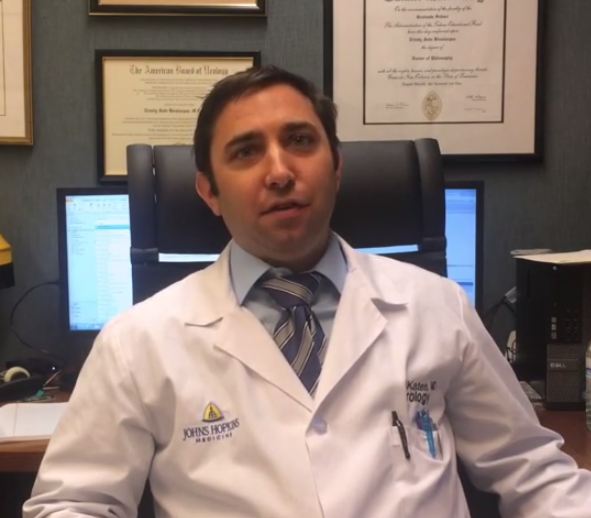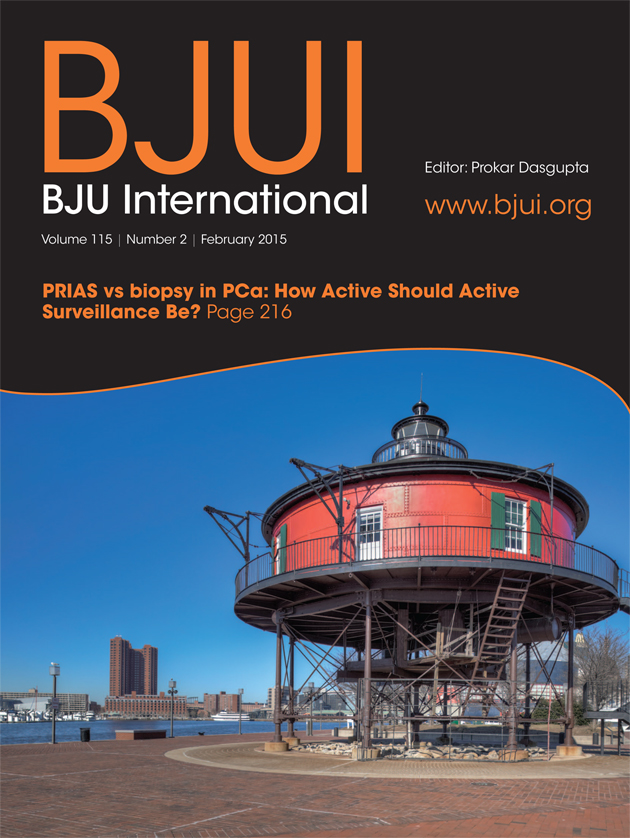
Video: Does TT status modify a man’s risk of cancer?
Testosterone Therapy and Cancer Risk
Michael L. Eisenberg*†, Shufeng Li*‡, Paul Betts§, Danielle Herder¶, Dolores J. Lamb¶ and Larry I. Lipshultz¶
Departments of *Urology, †Obstetrics/Gynecology and ‡Dermatology, Stanford University School of Medicine, Stanford, CA, §Cancer Epidemiology and Surveillance Branch, Texas Cancer Registry, Texas Department of State Health Services, Austin, TX, and ¶Scott Department of Urology, Baylor College of Medicine, Houston, TX,…

Article of the Month: Indications for Intervention During Active Surveillance of Prostate Cancer
Every week the Editor-in-Chief selects the Article of the Week from the current issue of BJUI. The abstract is reproduced below and you can click on the button to read the full article, which is freely available to all readers for at least 30 days from the time of this post.
In addition to the article itself, there is an accompanying editorial written by a prominent member of the urological community. This blog is intended to provoke comment and discussion and we invite you to use the comment…

Editorial: How active should active surveillance be?
1 Comment
/
Many investigators, including those from Johns Hopkins University (JHU) and the Prostate cancer Research International: Active Surveillance project (PRIAS), have provided meaningful data to strongly support the increasing use of active surveillance (AS) across the world. There are a multitude of strategies to minimise excessive rates of prostate cancer over detection and overtreatment. After the diagnosis of prostate cancer, the single best is AS for appropriately selected men.
For…

Video: Indications for Intervention During Active Surveillance of Prostate Cancer: A Comparison of the Johns Hopkins and PRIAS Protocols
Indications for Intervention During Active Surveillance of Prostate Cancer: A Comparison of the Johns Hopkins and PRIAS Protocols
Max Kates, Jeffrey J. Tosoian, Bruce J. Trock, Zhaoyong Feng, H. Ballentine Carter and Alan W. Partin
James Buchanan Brady Urological Institute, Johns Hopkins Medical Institutions, Baltimore, MD, USA
OBJECTIVE
To analyse how patients enrolled in our biopsy based surveillance programme would fare under the Prostate Cancer Research International Active Surveillance…

Article of the Week: An assessment of the physical impact of complex surgical tasks on surgeon errors and discomfort
Every week the Editor-in-Chief selects the Article of the Week from the current issue of BJUI. The abstract is reproduced below and you can click on the button to read the full article, which is freely available to all readers for at least 30 days from the time of this post.
In addition to the article itself, there is an accompanying editorial written by a prominent member of the urological community. This blog is intended to provoke comment and discussion and we invite you to use the comment…

Editorial: Conventional laparoscopic surgery – more pain, no gain!
Advances in surgical technology have revolutionized the way surgery is performed today. Conventional laparoscopic surgery dominated the surgical paradigm for several decades, until robot-assisted surgery created the next giant leap. In the pressent article, Elhage et al. [1] compare and correlate physical stress and surgical performances among three modes of a standardized surgical step. Their study shows the obvious physical strain and technical limitations faced while performing conventional…

Article of the Week: HLE and PVP for Patients with BPH and CUR
Every week the Editor-in-Chief selects the Article of the Week from the current issue of BJUI. The abstract is reproduced below and you can click on the button to read the full article, which is freely available to all readers for at least 30 days from the time of this post.
In addition to the article itself, there is an accompanying editorial written by a prominent member of the urological community. This blog is intended to provoke comment and discussion and we invite you to use the comment…

Editorial: Opening the flood gates – HLE is superior to PVP for the treatment of CUR
With the expansion in laser technology for treating symptomatic BPH, there are now two main techniques available to the budding urologist. Yet the management of chronic urinary retention (CUR) remains a significant challenge. In this issue of BJUI Jaeger et al. [1]present a retrospective study comparing holmium laser enucleation of the prostate (HoLEP) and photoselective vaporization of the prostate (PVP; using XPS 180 watt and HPS 120 watt systems) in the treatment of CUR.
Both HoLEP and…

Video: Holmium Laser Enucleation and Photoselective Vaporization of the Prostate for Patients with Benign Prostatic Hyperplasia and Chronic Urinary
Holmium Laser Enucleation and Photoselective Vaporization of the Prostate for Patients with Benign Prostatic Hyperplasia and Chronic Urinary Retention
Christopher D. Jaeger, Christopher R. Mitchell, Lance A. Mynderse and Amy E. Krambeck
Department of Urology, Mayo Clinic School of Medicine, Rochester, MN, USA
OBJECTIVES
To evaluate short-term outcomes of holmium laser enucleation of the prostate (HoLEP) and photoselective vaporisation of the prostate (PVP) in patients with benign…

Article of the Week: Enzalutamide in European and North American men participating in the AFFIRM trial
Every week the Editor-in-Chief selects the Article of the Week from the current issue of BJUI. The abstract is reproduced below and you can click on the button to read the full article, which is freely available to all readers for at least 30 days from the time of this post.
In addition to the article itself, there is an accompanying editorial written by a prominent member of the urological community. This blog is intended to provoke comment and discussion and we invite you to use the comment…
